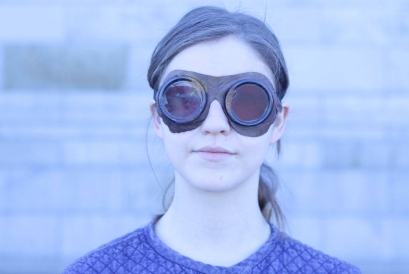I had the pleasure recently of seeing a work in progress by James Batchelor. Called FACES, Batchelor describes it as:
…a study of humans in transforming spaces and temporary constructions. From the trenches of the First World War to modern urban utopias, the work analyses sites of rapid evolution, a fluid interface of body and space. It is a portrait of anonymous faces; soldiers, refugees, nomads, vagrants, boom dockers, train hoppers and the homeless; bodies temporarily held in the relentless passage of time.
As with other explanatory notes relating to Batchelor’s works, I had to wonder how such a statement would (or could) translate into dance. Perhaps this is part of the fascination of Batchelor’s choreography? He arouses our curiosity, without being so abstruse as to alienate us, before we even arrive at the performing space.
The first section we saw was for three dancers, Batchelor himself, Amber McCartney and Chloe Chignell. The slow, careful, even meticulous moves made by the dancers as they progressed down the length of the studio space, moving along a pathway of silver coloured cloth, was transfixing. (It reminded me a little of a show I saw in New York several years ago by Butoh-style performers Eiko and Koma where they moved down a ramp covered in leaves taking the full performance time to reach the bottom). Then we watched as Batchelor, McCartney and Chignell manipulated the cloth in various ways and eventually tied it up with string, again with meticulous accuracy, into a package that to our surprise became a kind of long, joint backpack with images of the dancers’ faces attached to it.
In the second section Chignell and McCartney were joined by eleven dancers from Canberra’s youth ensemble, Quantum Leap. The standout moments of this section for me were in the highly complex yet seemingly simple structure of the choreography as rows of dancers moved up and down the room crossing past each other in simple lines. It had the repetitive feel that one experiences with a piece of music by Philip Glass, or from the look of a grey, grid painting by Agnes Martin, both Americans working in a minimalist manner. The apparent repetition in the works of Glass and Martin repays careful listening or looking when small variations or gradations indicate that there is greater complexity in the structure of their works than first meets the eye. Bouquets to the dancers for being in control of the mathematical intricacies of this section of choreography.
It is hard to know at this stage how the work will unfold. The first section shown in this preview had clear overtones of wartime, but the second had no such obvious context for me. How will they connect? Or will they? Where will they be performed given the apparent links, including through specific funding bodies, to the centenary of the ANZAC landing in 2015 (indoors or outdoors or both)? How will the connections with Canberra’s Quantum Leap dancers develop?
But full marks to Batchelor for having the courage to show FACES in its current, early stage of development. I look forward to future showings.
Michelle Potter, 22 December 2014
Featured image: Publicity shot for FACES

One thought on “FACES. A work in progress by James Batchelor”